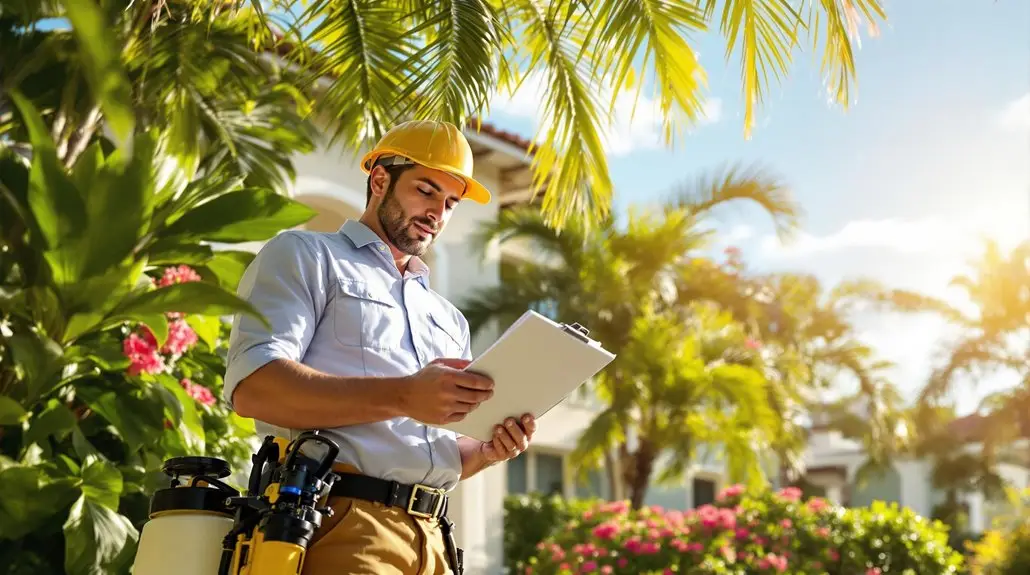Homeowners in South Florida should consider ten essential exterminator services to effectively manage local pest challenges. These services include termite inspections to prevent costly damage, tenting and fumigation for severe infestations, and non-tenting treatments that allow you to remain in your home. Additionally, effective rodent control, ant and cockroach management, and iguana removal are crucial for maintaining a healthy environment. Eco-friendly pest control options align with sustainable practices, while seasonal pest management strategies help address changing pest behaviors throughout the year. Choosing a reliable exterminator guarantees you receive quality service tailored to your specific needs, with further details awaiting your attention.
Key Insights
- Regular termite inspections are crucial in South Florida to prevent costly property damage from these wood-destroying pests.
- Effective rodent control involves identifying species and employing trapping techniques to minimize long-term infestations.
- Ant and cockroach management is essential for maintaining a healthy home environment, especially in humid climates.
- Bedbug extermination requires thorough inspections and tailored treatment plans, often needing follow-ups for complete elimination.
- Consider organic pest control options to protect health and the environment while effectively managing pest populations.
Termite Inspections
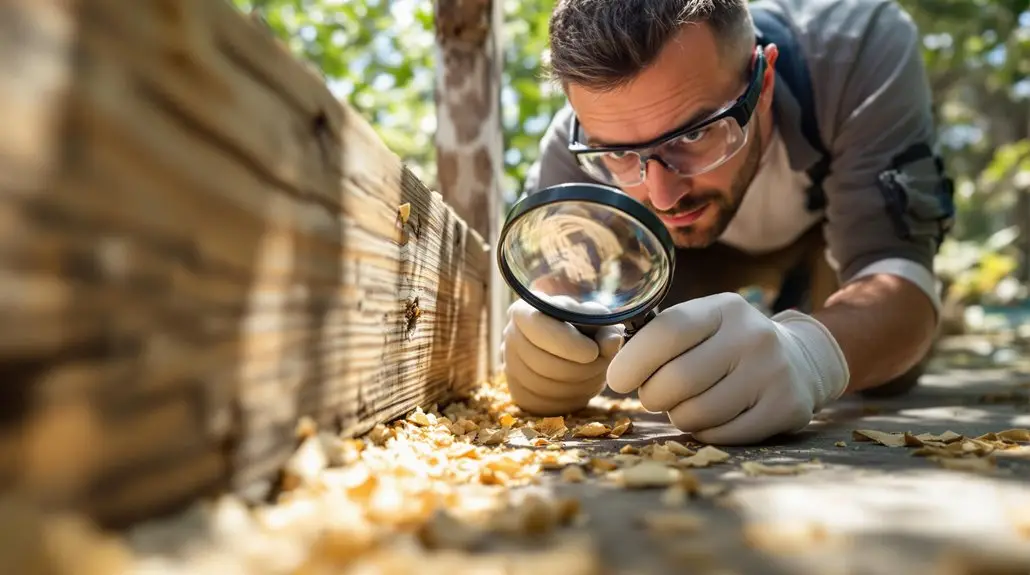
Recognizing the importance of termite inspections can save you from costly repairs down the line. Termites cause approximately $5 billion in property damage annually in the U.S., highlighting the necessity of proactive measures. A thorough termite inspection identifies not only active infestations but also conditions that may make your property susceptible, such as wood rot and excessive moisture. Regular inspections by trained professionals can identify minor issues before they escalate, allowing for timely intervention. Additionally, taking preventive measures, such as foundation trenching, can create long-lasting barriers against termites.
In several states, these inspections are mandatory before you can place a property under contract, underscoring their significance in real estate transactions.
During a termite inspection, professionals examine both the interior and exterior of your home for evidence of termites, including the pests themselves and signs such as wings, exit holes, or damage to wooden structures. They also look for indicators like cracks, hollowed wood, and bubbling paint, which suggest potential infestations.
If termites are discovered, pest control specialists develop customized treatment plans based on the specific type of termite and the extent of the infestation.
To stay ahead of potential issues, it’s advisable to conduct annual inspections to guarantee no new termite activity goes undetected. If you notice any signs of damage or if you’re selling your home, additional inspections may be warranted.
Regular inspections are generally affordable, ranging from $75 to $150, and neglecting them can lead to significant damage over time. Ultimately, maintaining a vigilant approach to termite inspections is vital for protecting your property and preserving its value.
Tenting and Fumigation
How can tenting and fumigation effectively eliminate stubborn termite infestations? This method involves enclosing your entire structure in a nylon fumigation tent or tarps, creating an airtight seal that allows for the introduction of a lethal concentration of fumigant gas.
This gas penetrates deep into the building, reaching hard-to-access areas such as attics and basements, guaranteeing thorough treatment of drywood termites and other wood-destroying pests, including powderpost beetles and old house borers. Additionally, this process ensures comprehensive pest control with a single treatment, making it a highly efficient solution. The use of advanced detection techniques can further enhance the effectiveness of pest management before and after fumigation.
Before fumigation, you’ll need to prepare your home by vacating the premises for approximately three days. During this time, it’s essential to drain water from fish tanks and other potable sources, seal unwrapped food, and relocate house plants to prevent contamination.
Additionally, you must verify at least 18 inches of clearance around your structure by trimming plants and moving vehicles. Compliance with safety protocols, such as disabling alarm systems and shutting off natural gas, is also vital.
Once the fumigation period is complete, the tent is removed, and the structure undergoes thorough aeration and ventilation to confirm the fumigant has dissipated, allowing for secure re-entry.
Post-fumigation testing is conducted using specialized devices to confirm the air quality is suitable for occupants. By following these procedures and utilizing certified professionals, you can assure the complete eradication of targeted pests, providing peace of mind and protecting your home from future infestations.
Non-Tenting Treatments
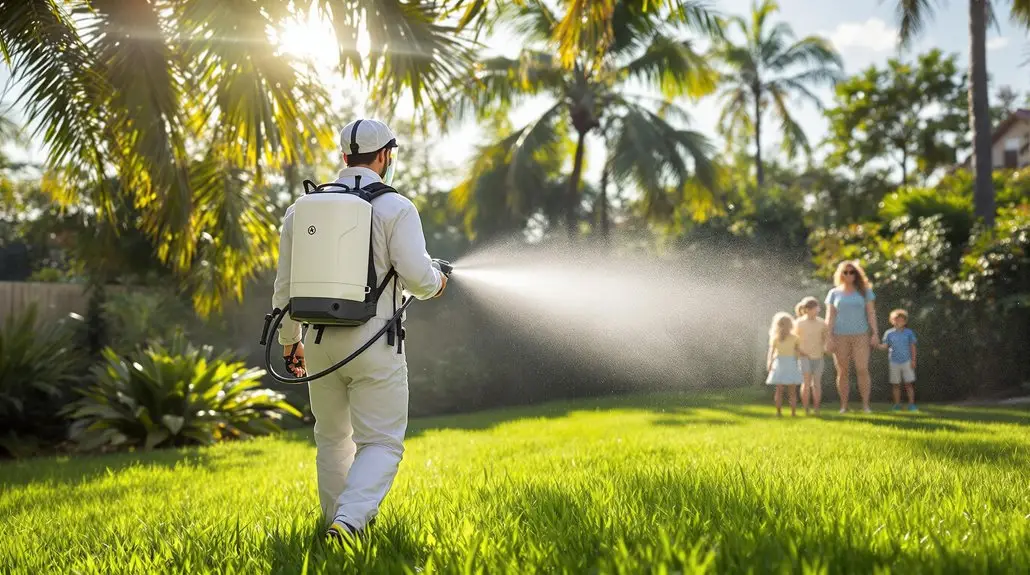
Non-tenting treatments offer a practical solution for homeowners dealing with termite infestations without the hassle of evacuation. These methods allow you to remain in your home during the treatment process, considerably reducing the inconvenience often associated with traditional tenting.
You’ll find that minimal preparation is required; there’s no need to remove food, medications, or plants, which makes the experience less stressful. Additionally, it’s important to note that drywood termites can thrive with minimal moisture, making these treatments effective even in less humid conditions. Many homeowners in South Florida also appreciate the organic pest control methods that minimize chemical exposure.
The effectiveness of non-tenting treatments lies in their direct injection method. Exterminators inject advanced, non-repellent products directly into the galleries of drywood termites. As termites come into contact with the treated surfaces, they inadvertently transfer the product throughout their colony, ultimately reaching and eliminating the queen.
This targeted approach minimizes unnecessary chemical exposure, focusing specifically on localized infestations, which is ideal for newer or smaller termite problems.
These treatments are particularly effective for drywood termites, commonly found in attics and other accessible areas. Additionally, the convenience of these services allows for quick completion, often within hours, enabling you to return to your normal activities promptly.
Professional exterminators bring expertise and access to advanced products, ensuring the treatments are both effective and secure for families and pets. Many services also provide warranties for ongoing protection against future infestations, giving you peace of mind.
With guaranteed results and a proactive approach, non-tenting treatments present a smart choice for homeowners seeking efficient and reliable termite solutions.
Rodent Control Solutions
When it comes to rodent control solutions, identifying the specific rodent species is essential, as this knowledge allows for the implementation of effective trapping techniques tailored to the behavior of the pests. You should also consider preventive measures to minimize future infestations, including proper food storage and regular inspections of your home. Additionally, partnering with a professional service can provide guaranteed rodent removal and ongoing monitoring to ensure your home remains rodent-free. Regular pest proofing can lead to long-term cost savings on pest management and help maintain a clean and safe living environment.
Identification of Rodent Species
Identifying rodent species in your home is vital for effective pest control, as different rodents require specific approaches for elimination. The most common species you might encounter include the house mouse, deer mouse, Norway rat, and roof rat.
The house mouse is small, nests in dark areas like walls and attics, and poses significant risks by chewing on electrical wires. In contrast, the deer mouse typically prefers outdoor nesting and is a primary carrier of Hantavirus, making it particularly hazardous to human health.
The Norway rat, the largest nuisance rat, burrows beneath homes and can cause severe structural damage while spreading diseases. Its brown or gray coloration and size, which can reach up to 10 inches, make it identifiable. Norway rats** can also act as vectors for various diseases, amplifying the need for immediate control measures if spotted.
Meanwhile, the roof rat, also known as the fruit rat, prefers elevated nesting sites like attics and trees, where it can chew through electrical wiring, increasing fire hazards.
Understanding these distinctions is essential, as it allows you to tailor your control strategies effectively, ensuring that your home remains secure from the various health risks associated with these rodent species.
Effective Trapping Techniques
How can you effectively tackle a rodent problem in your home? Implementing effective trapping techniques is essential for controlling rodent populations.
Here are four effective trapping methods to take into account:
- Snap Traps: These consist of a spring-loaded mechanism designed to quickly kill rodents. Available in different sizes, they should be placed along walls or in areas with high rodent activity. Regularly check them to remove any caught rodents. They offer a high success rate for quick capture or kill, effective for high rodent populations.
- Bait Stations or Poison Traps: These traps utilize rodenticides within secure plastic boxes, targeting multiple rodents at once. While effective, they require careful placement to protect pets and children from toxic substances.
- Glue Traps: These traps use a sticky adhesive surface to catch rodents. They’re easy to set up and can be utilized both indoors and outdoors, but may not be the most humane option due to the suffering they can cause.
- Live-Capture Traps: Offering a humane way to capture rodents, these traps don’t harm the animals. They require regular monitoring to release the captured rodents far from your home, making them a reusable and environmentally friendly solution. [Since they contain no toxic substances, they are an eco-friendly option.
Preventive Measures and Maintenance
Implementing preventive measures is essential for keeping rodents at bay and maintaining a pest-free home. Start by inspecting your property for gaps, cracks, or openings around windows, doors, utility lines, and vents; sealing these areas with caulk or weatherstripping effectively safeguards against rodent access.
Remember, even small gaps, as tiny as a quarter of an inch, can serve as entry points. Common locations include air conditioning chases and soffit vents, so consider hiring a pest control professional for thorough sealing.
Next, maintain cleanliness within your home. Regularly sweep and vacuum to eliminate food crumbs, store food in airtight containers, and keep both your home and surrounding areas tidy. It’s important to note that rodents have sharp incisors which allow them to gnaw through various materials in search of food.
Dispose of garbage frequently in tightly sealed bins to deny rodents food sources.
Additionally, focus on landscaping maintenance. Trim vegetation around your home to reduce hiding spots, and verify tree branches aren’t close enough for rodents to access roofs or attics.
Finally, prioritize proper storage and waste management by using plastic or metal containers for items, keeping pet food in rodent-proof containers, and fixing leaks to eliminate standing water.
These measures collectively contribute to a rodent-free environment.
Ant and Cockroach Management
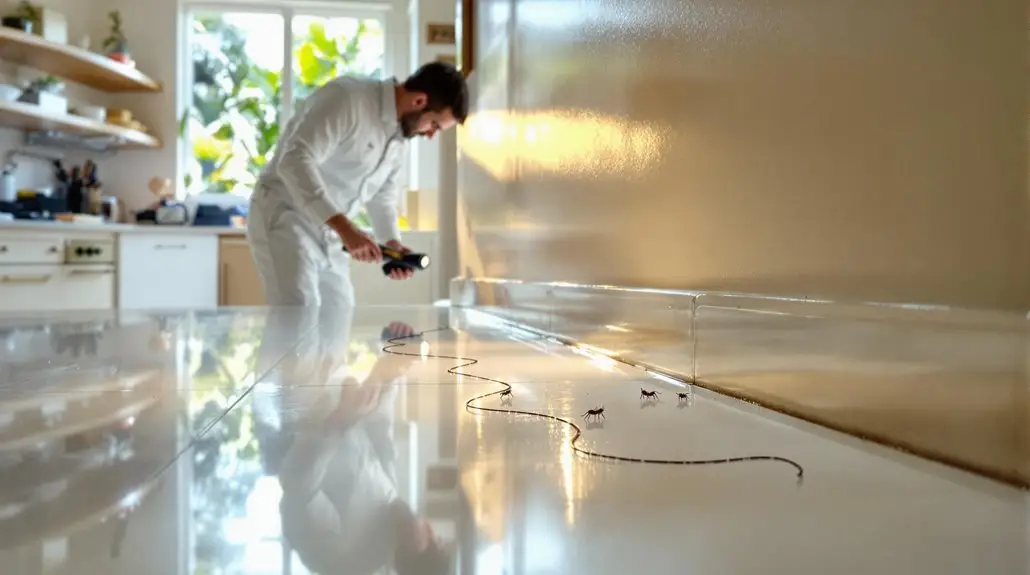
When it comes to managing ant and cockroach infestations, identifying the specific species in your home is essential for effective treatment. You’ll want to utilize targeted strategies, such as advanced baiting methods and sealing entry points, to eliminate these pests and prevent their return. Implementing a proactive pest control plan can further enhance your efforts by ensuring ongoing protection against future infestations. Additionally, consider utilizing organic pest control methods to minimize environmental impact while effectively addressing the problem.
Identification of Infestations
- Ant Trails: Look for pheromone scent trails, which are often visible on kitchen counters, floors, and walls. A trail of ants indicates active foraging by the colony.
- Droppings: For cockroaches, tiny droppings resembling pepper specks or coffee grounds signify an infestation. High amounts of droppings are particularly alarming. Some ants can carry and spread bacteria during foraging, which can pose health risks.
- Nests and Piles of Dirt: Ant nests may appear as small piles of soil near water sources or in wall voids. Similarly, inspect the perimeter of your home for dirt piles, indicating nesting activities.
- Shed Skins and Smear Marks: Cockroaches shed their skins multiple times, which can be found in their hiding spaces. Additionally, brown smear marks in moist areas suggest roach activity.
Effective Treatment Strategies
Effective treatment strategies for managing ant and cockroach infestations focus on a combination of cleanliness, prevention, and targeted interventions.
First, maintaining a clean environment is essential; you should regularly wipe down surfaces, sweep floors, and store food in airtight containers to eliminate attractants. In addition, fixing leaky pipes and ensuring trash is stored in covered bins will help reduce moisture and food sources. Additionally, being aware of common ant species like Ghost Ants can help identify specific attractants related to their behavior.
Next, sealing entry points is vital for both pests. You can seal gaps around windows and doors with caulk, install door sweeps, and repair screens to prevent unwanted access.
Moreover, keeping landscaping tidy—trimming bushes and maintaining a mowed lawn—creates barriers that discourage pests from approaching your home.
For targeted interventions, using baits and traps in areas of high activity can effectively reduce populations.
Employing natural remedies like diatomaceous earth or boric acid provides non-toxic alternatives, while professional pest control services offer thorough treatments tailored to specific infestations.
Bedbug Extermination Services
Dealing with a bedbug infestation can be overwhelming, but professional extermination services offer a reliable solution. Bedbugs are notorious for their resilience, making it challenging to eliminate them without expert assistance.
By utilizing trained specialists, you can guarantee accurate identification and effective treatment of these pests. Here’s what you can expect from bedbug extermination services:
- Thorough Inspection: Professionals will conduct a detailed property inspection, checking mattresses, baseboards, and upholstered furniture for signs of infestation, such as droppings and shed skins.
- Effective Treatment Options: They often use a combination of methods. Heat treatments raise the temperature in your home to at least 120 degrees Fahrenheit, killing all life stages of bedbugs. Chemical treatments may also be applied, although resistance can occur. For those concerned about chemicals, organic pest control options are available.
- Preparation Guidance: Before treatment, you’ll need to prepare your home by cleaning areas, removing personal items, and securing pets, following specific instructions from the exterminator.
- Follow-Up Inspections: After treatment, follow-up inspections guarantee that the extermination was successful, and ongoing control tips help prevent future infestations. Additionally, it’s important to recognize that bed bugs are declared a public health pest due to their potential to cause health risks related to their bites and associated infections.
Iguana Removal and Prevention
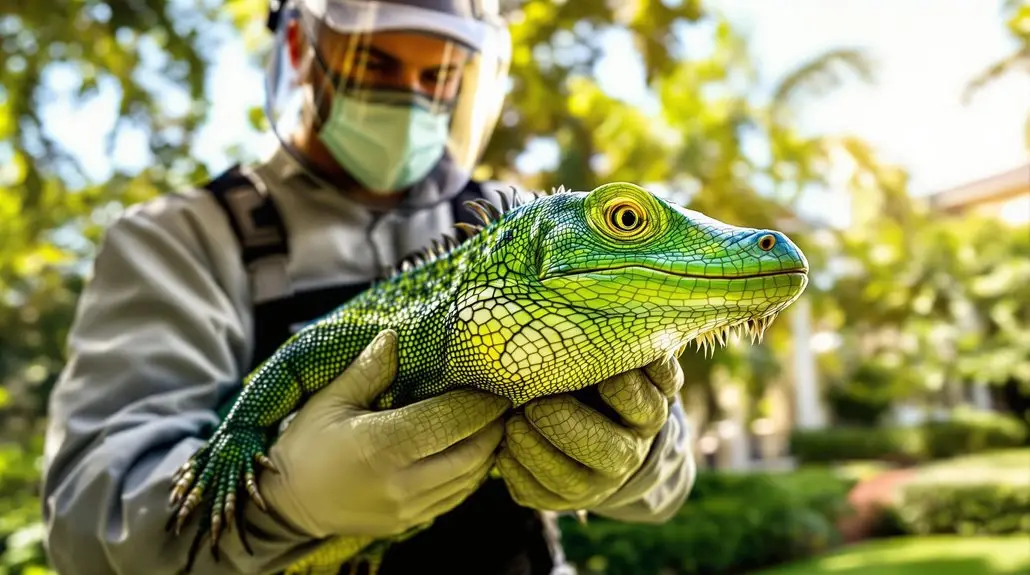
When dealing with iguanas, it’s essential to assess the health risks they pose, as their feces can carry diseases like salmonella, which may affect both humans and pets.
Implementing effective entry prevention strategies, such as sealing gaps and installing barriers, can greatly reduce the chances of these reptiles invading your property.
Additionally, employing secure removal techniques, guided by wildlife experts, guarantees that the process is humane and minimizes stress for the animals involved.
Health Risks Assessment
Iguanas can pose significant health risks for homeowners, making a thorough health risks assessment essential for effective removal and prevention. Understanding these risks can help you take appropriate measures to protect your home and family.
Here are four key health concerns associated with iguanas:
- Salmonella Infection: Iguanas can carry salmonella bacteria, which may be transferred to humans through direct contact or their droppings, potentially causing severe gastrointestinal issues.
- Mycobacterium Marinum: A bite from an iguana can result in a rare bacterial infection known as mycobacterium marinum, often requiring specialized medical treatment.
- Skin and Wound Infections: Contact with iguana feces or skin can lead to infections, highlighting the need for proper hygiene when handling iguana-related materials.
- Physical Injuries: Cornered iguanas may bite or scratch, inflicting pain and injury, while their powerful tails can also cause harm if threatened.
Entry Prevention Strategies
To keep iguanas at bay, homeowners need to implement effective entry prevention strategies.
Start by managing your trees and shrubs; trim them regularly to prevent iguanas from using them as bridges to access roofs and homes. By thinning out overgrown areas and removing branches that are close to your house, you can reduce potential hiding spots and climbing routes.
Next, address any iguana burrows on your property. Fill these holes with more than just dirt—incorporate large rocks before adding soil to deter re-digging. It’s best to fill these holes during the day when iguanas are less active.
Additionally, consider installing barriers, such as iguana-proof fences around your perimeter and L-shaped wire barriers to prevent digging.
Finally, remove any attractants that may draw iguanas to your yard, such as certain food sources and plants. You can also use deterrents like reflective objects, loud noises, or homemade repellents made from natural ingredients.
Safe Removal Techniques
Effective iguana removal techniques are vital for homeowners facing the challenges these reptiles present. Utilizing humane trapping methods not only guarantees the secure handling of iguanas but also complies with Florida’s anticruelty laws.
Here are four key aspects of secure removal techniques:
- Humane Trapping: Employ approved traps or hand-catching methods to minimize harm to iguanas and other wildlife.
- Professional Expertise: Engage veteran and firefighter-owned companies, like Iguana Busters or Redline Iguana Removal, which bring experience and integrity to the process.
- Health and Safety Precautions: Guarantee that removal services handle and dispose of iguanas securely, preventing the spread of diseases carried by iguana feces that could affect humans and pets.
- Property Protection: Address potential property damage by removing iguanas, which can dig extensive burrows or damage landscaping, roofs, and seawalls.
Eco-Friendly Pest Control Options
As homeowners become more conscious of their environmental impact, eco-friendly pest control options are gaining popularity. These solutions not only protect your health and household pets from toxic substances, but they also minimize harm to the environment, wildlife, and the ecosystem. By reducing the risk of soil and water contamination from chemical pesticides, eco-friendly methods align with the growing trend toward sustainable living, guaranteeing a more secure, healthier living environment for current and future generations.
To effectively implement eco-friendly pest control, consider the following green pest management practices:
| Practice | Description |
|---|---|
| Inspection and Monitoring | Regularly check your home for potential pest entry points and infestations. |
| Exclusion | Seal cracks and crevices to prevent pests from entering your home. |
| Natural Alternatives | Use gel baits, organic dust, and essential oils like peppermint and lavender. |
In addition to these practices, it’s essential to research local pest control companies specializing in organic pest management. Verify their credentials, check for transparency regarding their techniques, and confirm they address various pests common in South Florida. Selecting a service that emphasizes long-term prevention and Integrated Pest Management (IPM) can ultimately help you maintain an eco-friendly approach while effectively managing pest issues.
Seasonal Pest Management
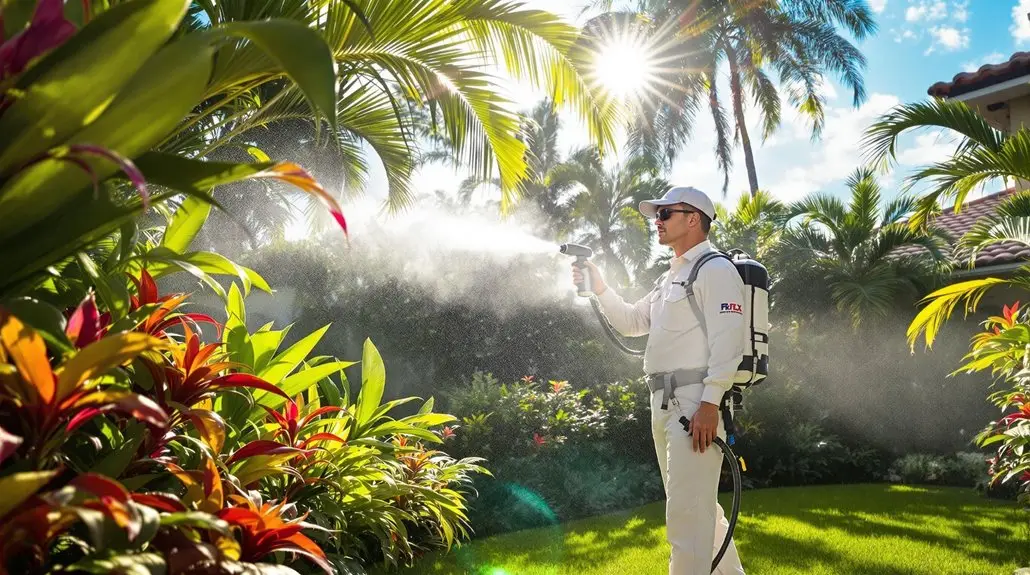
Seasonal pest management is fundamental for homeowners looking to maintain a pest-free environment year-round. Different seasons bring unique challenges, and understanding these can help you stay ahead of potential infestations. Here are four important considerations for managing seasonal pests effectively:
- Spring: Increased temperatures and rainfall trigger higher insect activity. As bees, wasps, and other stinging insects start mating, you should prune shrubs and maintain a clear perimeter around your property to deter them. Ants also become active, often building nests near food sources, so vigilance is essential.
- Summer: The intense heat and humidity create ideal conditions for pests like termites and mosquitoes. You should conduct annual termite inspections to catch any early activity and treat standing water with larvicides to control mosquito breeding. Additionally, applying adulticides in areas with high pest activity can help mitigate infestations. It’s important to remember that mosquitoes can transmit diseases, making their control a priority during this season.
- Fall: As temperatures drop, pests such as ghost ants and yellow jackets remain active, posing risks to your home. Inspecting and sealing entry points is crucial to prevent rodents, which may seek shelter indoors during cooler months.
- Winter: Despite cooler weather, pests like bedbugs and cockroaches can still pose significant problems. Installing traps and baits in attics and crawlspaces helps deter rodents, while maintaining a clean environment can minimize their presence.
Choosing a Reliable Exterminator
Maintaining a pest-free home often requires professional help, especially when infestations become overwhelming. To begin, you should identify the type of pest invading your space, as different pests necessitate specialized exterminators who understand the specific treatment methods required.
Assess the severity of the infestation by looking for signs such as droppings, damage to wood or food packaging, and nests, which can indicate whether you need immediate professional intervention or if the issue is manageable on your own.
Once you’ve evaluated your pest problem, it’s time to research local exterminators. Look for professionals with extensive experience in managing South Florida’s unique pest landscape, guaranteeing they’re licensed and certified by the Florida Department of Agriculture and Consumer Services (FDACS).
Read customer reviews and testimonials to gauge the exterminator’s reputation, and don’t hesitate to compare quotes from at least three different providers to determine the best price and service offerings.
Evaluate the treatment methods each exterminator employs, considering both chemical and non-chemical options. Ask about the security of these treatments, especially concerning pets and children, and confirm the exterminator provides clear instructions for preparation before treatment begins. Additionally, inquire whether the exterminator uses eco-friendly products to minimize environmental impact and ensure the safety of your household.
Finally, verify that the exterminator carries general liability insurance, complies with state regulations, and meets continuing education requirements to stay updated on effective pest management practices. By approaching the selection process methodically, you can choose a reliable exterminator that meets your specific needs.
Frequently Asked Questions
How Often Should I Schedule Pest Control Services?
To determine how often you should schedule pest control services, consider the severity of any infestations.
For mild issues, quarterly treatments typically suffice, while severe infestations may require monthly or biweekly visits.
Severe cases, such as those involving roaches or fleas, often necessitate weekly treatments until resolved.
Regular monitoring and preventive measures, including inspections and treatments, ultimately help maintain a pest-free environment, reducing the likelihood of reinfestation and ensuring effective control.
Are Pest Control Treatments Safe for Children and Pets?
When considering pest control treatments, imagine a carefully choreographed dance between security and efficacy.
Most treatments can be secure for children and pets if applied correctly and with precautions. You should inform pest control services about your family situation, remove items from treatment areas, and follow label instructions meticulously.
Ensuring proper ventilation and waiting for treatments to dry before reentry further minimizes any risk, allowing your household to remain secure while combating pests effectively.
What Should I Do Before an Extermination Appointment?
Before your extermination appointment, gather detailed information about the pests, including their locations and any damage.
Declutter your spaces, ensuring technicians can access treatment areas efficiently. Clean surfaces, dispose of trash, and eliminate standing water.
Seal any openings to deter new pests. Move family members and pets away from treatment areas.
Finally, follow any specific instructions your pest control technician provides to enhance the effectiveness of the treatment process.
How Can I Prevent Pests From Returning After Treatment?
To prevent pests from returning after treatment, you should maintain a clean environment, sealing food containers and promptly cleaning spills.
Regularly inspecting your home for entry points and sealing cracks will deter pests.
Additionally, consider implementing ongoing preventive measures, such as scheduled treatments and monitoring for signs of infestation.
Utilizing eco-friendly repellents can also assist in creating an unfavorable environment for pests, ensuring your proactive efforts effectively diminish their chances of re-establishing themselves.
What Signs Indicate I Need Pest Control Services Immediately?
If you notice that 14% of households experience recurrent pest infestations, it’s essential to act swiftly.
Signs indicating the need for immediate pest control include frequent pest sightings, damage to property, and the presence of droppings or dead bodies.
Unusual odors and noises, like scratching sounds at night, can also signal significant infestations.
Addressing these issues promptly can help prevent further damage and health risks associated with pest populations in your home.

